Responses of Rotifer Community to Microhabitat Changes Caused by Summer-Concentrated Rainfall in a Shallow Reservoir, South Korea
Abstract
1. Introduction
2. Materials and Methods
2.1. Description of Study Site
2.2. Monitoring Strategy
2.3. Data Analysis
3. Results
3.1. Rainfall, Environmental Variables, and Rotifer Distribution
3.2. Rotifers, Area of Open Water, and Submerged Macrophyte between Dry and Rainy Years
3.3. Influence of Autumn Biomass of Submerged Macrophytes on Fish
4. Discussion
4.1. Impact of Summer Rainfall on Rotifer Groups
4.2. Seasonality of Microhabitat Structures that Support Rotifer Communites
4.3. Association between Macrophytes and Fish Predation
4.4. Effect of Summer Rainfall on Rotifer Diversity
Author Contributions
Funding
Conflicts of Interest
References
- Lau, K.M.; Li, M.T. The monsoon of East Asia and its global associations-A survey. Bull. Am. Meteorol. Soc. 1984, 65, 114–125. [Google Scholar] [CrossRef]
- An, Z. The history and variability of the East Asian paleomonsoon climate. Quat. Sci. Rev. 2000, 19, 171–187. [Google Scholar] [CrossRef]
- Ha, K.; Jang, M.H.; Joo, G.J. Spatial and temporal dynamics of phytoplankton communities along a regulated river system, the Nakdong River, Korea. Hydrobiologia 2002, 470, 235–245. [Google Scholar] [CrossRef]
- Znachor, P.; Zapomělová, E.; Řeháková, K.; Nedoma, J.; Šimek, K. The effect of extreme rainfall on summer succession and vertical distribution of phytoplankton in a lacustrine part of a eutrophic reservoir. Aquat. Sci. 2008, 70, 77–86. [Google Scholar] [CrossRef]
- Hobbs, R.J.; Mooney, H.A. Effects of rainfall variability and gopher disturbance on serpentine annual grassland dynamics. Ecology 1991, 72, 59–68. [Google Scholar] [CrossRef]
- Theodoropoulos, C.; Vourka, A.; Stamou, A.; Rutschmann, P.; Skoulikidis, N. Response of freshwater macroinvertebrates to rainfall-induced high flows: A hydroecological approach. Ecol. Indic. 2017, 73, 432–442. [Google Scholar] [CrossRef]
- Zhou, Y.; Kellermann, C.; Griebler, C. Spatio-temporal patterns of microbial communities in a hydrologically dynamic pristine aquifer. FEMS Microbiol. Ecol. 2012, 81, 230–242. [Google Scholar] [CrossRef]
- Duncan, J.M.; Biggs, E.M.; Dash, J.; Atkinson, P.M. Spatio-temporal trends in precipitation and their implications for water resources management in climate-sensitive Nepal. Appl. Geogr. 2013, 43, 138–146. [Google Scholar] [CrossRef]
- Boix, D.; Sala, J.; Quintana, X.D.; Moreno-Amich, R. Succession of the animal community in a Mediterranean temporary pond. J. North Am. Benthol. Soc. 2004, 23, 29–49. [Google Scholar] [CrossRef]
- Brucet, S.; Boix, D.; López-Flores, R.; Badosa, A.; Moreno-Amich, R.; Quintana, X.D. Zooplankton structure and dynamics in permanent and temporary Mediterranean salt marshes: taxon-based and size-based approaches. Arch. Hydrobiol. 2005, 162, 535–555. [Google Scholar] [CrossRef]
- Campbell, C.E. Rainfall events and downstream drift of microcrustacean zooplankton in a Newfoundland boreal stream. Can. J. Zool. 2002, 80, 997–1003. [Google Scholar] [CrossRef]
- Choi, J.Y.; Jeong, K.S.; Kim, H.W.; Chang, K.H.; Joo, G.J. Inter-annual variability of a zooplankton community: the importance of summer concentrated rainfall in a regulated river ecosystem. J. Ecol. Environ. 2011, 34, 49–58. [Google Scholar] [CrossRef][Green Version]
- Czerniawski, R.; Domagała, J. Reduction of zooplankton communities in small lake outlets in relation to abiotic and biotic factors. Oceanol. Hydrobiol. Stud. 2013, 42, 123–131. [Google Scholar] [CrossRef]
- Medeiros, A.M.A.; Barbosa, J.E.L.; Medeiros, P.R.; Rocha, R.M.; Silva, L.F. Salinity and freshwater discharge determine rotifer distribution at the Mossoró River Estuary (Semiarid Region of Brazil). Braz. J. Biol. 2010, 70, 551–557. [Google Scholar] [CrossRef]
- Vázquez-Sánchez, A.; Reyes-Vanegas, G.; Nandini, S.; Sarma, S.S.S. Diversity and abundance of rotifers during an annual cycle in the reservoir Valerio Trujano (Tepecoacuilco, Guerrero, Mexico). Inland Waters 2014, 4, 293–302. [Google Scholar] [CrossRef]
- Lair, N. A review of regulation mechanisms of metazoan plankton in riverine ecosystems: aquatic habitat versus biota. River Res. Appl. 2006, 22, 567–593. [Google Scholar] [CrossRef]
- Ferreiro, N.; Feijoó, C.; Giorgi, A.; Leggieri, L. Effects of macrophyte heterogeneity and food availability on structural parameters of the macroinvertebrate community in a Pampean stream. Hydrobiologia 2011, 664, 199–211. [Google Scholar] [CrossRef]
- Sousa, W.T.; Thomaz, S.M.; Murphy, K.J. Drivers of aquatic macrophyte community structure in a Neotropical riverine lake. Acta. Oecol. 2011, 37, 462–475. [Google Scholar] [CrossRef]
- Choi, J.Y.; Jeong, K.S.; Kim, S.K.; La, G.H.; Chang, K.H.; Joo, G.J. Role of macrophytes as microhabitats for zooplankton community in lentic freshwater ecosystems of South Korea. Ecol. Inform. 2014, 24, 177–185. [Google Scholar] [CrossRef]
- Stansfield, J.H.; Perrow, M.R.; Tench, L.D.; Jowitt, A.J.D.; Taylor, A.A.L. Submerged macrophytes as refuges for grazing Cladocera against fish predation: observations on seasonal changes in relation to macrophyte cover and predation pressure. In Shallow Lakes ’95; Kufel, L., Prejs, A., Rybak, J.I., Eds.; Springer: Dordrecht, The Netherlands, 1997; pp. 229–240. [Google Scholar]
- Manatunge, J.; Asaeda, T.; Priyadarshana, T. The influence of structural complexity on fish-zooplankton interactions: A study using artificial submerged macrophytes. Environ. Biol. Fish. 2000, 58, 425–438. [Google Scholar] [CrossRef]
- Choi, J.Y.; Jeong, K.S.; Joo, G.J. Rainfall as dominant driver of rotifer dynamics in shallow wetlands: Evidence from a long-term data record (Upo Wetlands, South Korea). Int. Rev. Hydrobiol. 2015, 100, 21–33. [Google Scholar] [CrossRef]
- Nicolle, A.; Hansson, L.A.; Brönmark, C. Habitat structure and juvenile fish ontogeny shape zooplankton spring dynamics. Hydrobiologia 2010, 652, 119–125. [Google Scholar] [CrossRef]
- Choi, J.Y.; Jeong, K.S.; La, G.H.; Kim, S.K.; Joo, G.J. Sustainment of epiphytic microinvertebrate assemblage in relation with different aquatic plant microhabitats in freshwater wetlands (South Korea). J. Limnol. 2014, 73, 11–16. [Google Scholar] [CrossRef]
- Jeppesen, E.; Lauridsen, T.L.; Kairesalo, T.; Perrow, M.R. Impact of submerged macrophytes on fish-zooplankton interactions in lakes. In The Structuring Role of Submerged Macrophytes in Lakes; Jeppesen, E., Søndergaard, M., Søndergaard, M., Christoffersen, K., Eds.; Springer: New York, NY, USA, 1998; pp. 91–114. [Google Scholar]
- Cheng, S. Ecological interaction between submerged macrophytes and zoobenthos. J. Earth Sci. Environ. Stud. 2017, 2, 173–182. [Google Scholar]
- Michelan, T.S.; Thomaz, S.M.; Mormul, R.P.; Carvalho, P. Effects of an exotic invasive macrophyte (tropical signalgrass) on native plant community composition, species richness and functional diversity. Freshw. Biol. 2010, 55, 1315–1326. [Google Scholar] [CrossRef]
- Jeong, K.S.; Kim, D.K.; Joo, G.J. Delayed influence of dam storage and discharge on the determination of seasonal proliferations of Microcystis aeruginosa and Stephanodiscus hantzschii in a regulated river system of the lower Nakdong River (South Korea). Water Res. 2007, 41, 1269–1279. [Google Scholar] [CrossRef]
- Haney, J.F.; Hall, D.J. Sugar-coated Daphnia: A preservation technique for Cladocera 1. Limnol. Oceanogr. 1973, 18, 331–333. [Google Scholar] [CrossRef]
- Mizuno, T.; Takahashi, E. An Illustrated Guide to Freshwater Zooplankton in Japan; Tokai University Press: Tokyo, Japan, 1999; p. 532. [Google Scholar]
- Sakuma, M.; Hanazato, T.; Nakazato, R.; Haga, H. Methods for quantitative sampling of epiphytic microinvertebrates in lake vegetation. Limnology 2002, 3, 115–119. [Google Scholar] [CrossRef]
- Gyllström, M.; Hansson, L.A.; Jeppesen, E.; Criado, F.G.; Gross, E.; Irvine, K.; Kairesalo, T.; Kornijow, R.; Miracle, M.R.; Nykänen, M.; et al. The role of Climate in shaping zooplankton communities of shallow lakes. Limnol. Oceanogr. 2005, 50, 2008–2021. [Google Scholar] [CrossRef]
- Kim, I.S.; Park, J.Y. Freshwater Fish of Korea; Kyo-Hak Publishing Co., Ltd.: Seoul, Korea, 2002. [Google Scholar]
- Nelson, J.S. Fishes of the World, 3rd ed.; Wiely: New York, NY, USA, 1994. [Google Scholar]
- Shannon, C.E.; Weaver, W. A Mathematical Theory of Communication; University of Illinois Press: Urbana, IL, USA, 1949. [Google Scholar]
- Clarke, K.R. Non-parametric multivariate analysis of changes in community structure. Aust. J. Ecol. 1993, 18, 117–143. [Google Scholar] [CrossRef]
- Oksanen, J.; Blanchet, F.G.; Kindt, R.; Legendre, P.; Minchin, P.R.; O’Hara, R.B.; Simpson, G.L.; Solymos, P.; Stevens, M.H.H.; Wagner, H. Package ‘Vegan’. Community Ecology Package, Version 2. 2013. Available online: http://cran.r-project.org/web/packages/vegan/index.html (accessed on 8 January 2020).
- O’Farrell, I.; Lombardo, R.J.; de Tezanos Pinto, P.; Loez, C. The assessment of water quality in the Lower Luján River (Buenos Aires, Argentina): phytoplankton and algal bioassays. Environ. Pollut. 2002, 120, 207–218. [Google Scholar] [CrossRef]
- Chaparro, G.; Marinone, M.C.; Lombardo, R.J.; Schiaffino, M.R.; de Souza Guimarães, A.; O’Farrell, I. Zooplankton succession during extraordinary drought–flood cycles: a case study in a South American floodplain lake. Limnologica 2011, 41, 371–381. [Google Scholar] [CrossRef]
- Havel, J.E.; Eisenbacher, E.M.; Black, A.A. Diversity of crustacean zooplankton in riparian wetlands: colonization and egg banks. Aquat. Ecol. 2000, 34, 63–76. [Google Scholar] [CrossRef]
- Yamazaki, H.; Squires, K.D. Comparison of oceanic turbulence and copepod swimming. Mar. Ecol. Prog. Ser. 1996, 144, 299–301. [Google Scholar] [CrossRef]
- Frisch, D. Dormancy, dispersal and the survival of cyclopoid copepods (Cyclopoida, Copepoda) in a lowland floodplain. Freshw. Biol. 2002, 47, 1269–1281. [Google Scholar] [CrossRef]
- Muzaffar, S.B.; Ahmed, F.A. The effects of the flood cycle on the diversity and composition of the phytoplankton community of a seasonally flooded Ramsar wetland in Bangladesh. Wetl. Ecol. Manag. 2007, 15, 81–93. [Google Scholar] [CrossRef]
- Zhao, S.; Peng, C.; Jiang, H.; Tian, D.; Lei, X.; Zhou, X. Land use change in Asia and the ecological consequences. Ecol. Res. 2006, 21, 890–896. [Google Scholar] [CrossRef]
- Henry-Silva, G.G.; Camargo, A.F.; Pezzato, M.M. Growth of free-floating aquatic macrophytes in different concentrations of nutrients. Hydrobiologia 2008, 610, 153. [Google Scholar] [CrossRef]
- Hatzenbeler, G.R.; Bozek, M.A.; Jennings, M.J.; Emmons, E.E. Seasonal variation in fish assemblage structure and habitat structure in the nearshore littoral zone of Wisconsin lakes. N. Am. J. Fish. Manag. 2000, 20, 360–368. [Google Scholar] [CrossRef]
- Estlander, S.; Nurminen, L.; Olin, M.; Vinni, M.; Horppila, J. Seasonal fluctuations in macrophyte cover and water transparency of four brown-water lakes: implications for crustacean zooplankton in littoral and pelagic habitats. Hydrobiologia 2009, 620, 109–120. [Google Scholar] [CrossRef]
- Espinosa-Rodríguez, C.A.; Sarma, S.S.S.; Nandini, S. Effect of the allelochemicals from the macrophyte Egeria densa on the competitive interactions of pelagic and littoral cladocerans. Chem. Ecol. 2017, 33, 247–256. [Google Scholar] [CrossRef]
- Murray, G.P.; Stillman, R.A.; Britton, J.R. Habitat complexity and food item size modify the foraging behaviour of a freshwater fish. Hydrobiologia 2016, 766, 321–332. [Google Scholar] [CrossRef]
- Špoljar, M.; Dražina, T.; Šargač, J.; Borojević, K.K.; Žutinić, P. Submerged macrophytes as a habitat for zooplankton development in two reservoirs of a flow-through system (Papuk Nature Park, Croatia). Ann. Limnol-Int. J. Limnol. 2012, 48, 161–175. [Google Scholar] [CrossRef]
- Choi, J.Y.; Jeong, K.S.; Kim, S.K.; Joo, G.J. Impact of habitat heterogeneity on the biodiversity and density of the zooplankton community in shallow wetlands (Upo wetlands, South Korea). Oceanol. Hydrobiol. Stud. 2016, 45, 485–492. [Google Scholar] [CrossRef]
- Kuczyńska-Kippen, N.; Joniak, T. Zooplankton diversity and macrophyte biometry in shallow water bodies of various trophic state. Hydrobiologia 2016, 774, 39–51. [Google Scholar] [CrossRef]
- Priyadarshana, T.; Asaeda, T.; Manatunge, J. Foraging behaviour of planktivorous fish in artificial vegetation: the effects on swimming and feeding. Hydrobiologia 2001, 442, 231–239. [Google Scholar] [CrossRef]
- Grenouillet, G.; Pont, D. Juvenile fishes in macrophyte beds: Influence of food resources, habitat structure and body size. J. Fish Biol. 2001, 59, 939–959. [Google Scholar] [CrossRef]
- Savino, J.F.; Stein, R.A. Behavior of fish predators and their prey: Habitat choice between open water and dense vegetation. Environ. Biol. Fishes 1989, 24, 287–293. [Google Scholar] [CrossRef]
- Choi, J.Y.; Kim, S.K.; Kim, J.C.; Yoon, J.D. Trophic position and diet shift based on the body size of Coreoperca kawamebari (Temminck & Schlegel, 1843). J. Ecol. Environ. 2020, 44, 1–7. [Google Scholar]
- Diehl, S.; Kornijów, R. Influence of submerged macrophytes on trophic interactions among fish and macroinvertebrates. In The Structuring Role of Submerged Macrophytes in Lakes; Springer: New York, NY, USA, 1998; pp. 24–46. [Google Scholar]
- Warfe, D.M.; Barmuta, L.A. Habitat structural complexity mediates the foraging success of multiple predator species. Oecologia 2004, 141, 171–178. [Google Scholar] [CrossRef]
- Ross, R.M.; Quetin, L.B.; Martinson, D.G.; Iannuzzi, R.A.; Stammerjohn, S.E.; Smith, R.C. Palmer LTER: Patterns of distribution of five dominant zooplankton species in the epipelagic zone west of the Antarctic Peninsula, 1993–2004. Deep Sea Res. Part II Top. Stud. Oceanogr. 2008, 55, 2086–2105. [Google Scholar] [CrossRef]
- Blois-Heulin, C.; Crowley, P.H.; Arrington, M.; Johnson, D.M. Direct and indirect effects of predators on the dominant invertebrates of two freshwater littoral communities. Oecologia 1990, 84, 295–306. [Google Scholar] [CrossRef]
- Litchman, E.; Ohman, M.D.; Kiørboe, T. Trait-based approaches to zooplankton communities. J. Plankton Res. 2013, 35, 473–484. [Google Scholar] [CrossRef]
- Carter, J.L.; Schindler, D.E.; Francis, T.B. Effects of climate change on zooplankton community interactions in an Alaskan lake. Clim. Chang. Responses 2017, 4, 3. [Google Scholar] [CrossRef]
- Kim, H.W.; Joo, G.J. The longitudinal distribution and community dynamics of zooplankton in a regulated large river: a case study of the Nakdong River (Korea). Hydrobiologia 2000, 438, 171–184. [Google Scholar] [CrossRef]
- Croft, M.V.; Chow-Fraser, P. Use and development of the wetland macrophyte index to detect water quality impairment in fish habitat of Great Lakes coastal marshes. J. Great Lakes Res. 2007, 33, 172–197. [Google Scholar] [CrossRef]
- Pedersen, M.L.; Friberg, N.; Skriver, J.; Baattrup-Pedersen, A.; Larsen, S.E. Restoration of Skjern River and its valley—Short-term effects on river habitats, macrophytes and macroinvertebrates. Ecol. Eng. 2007, 30, 145–156. [Google Scholar] [CrossRef]
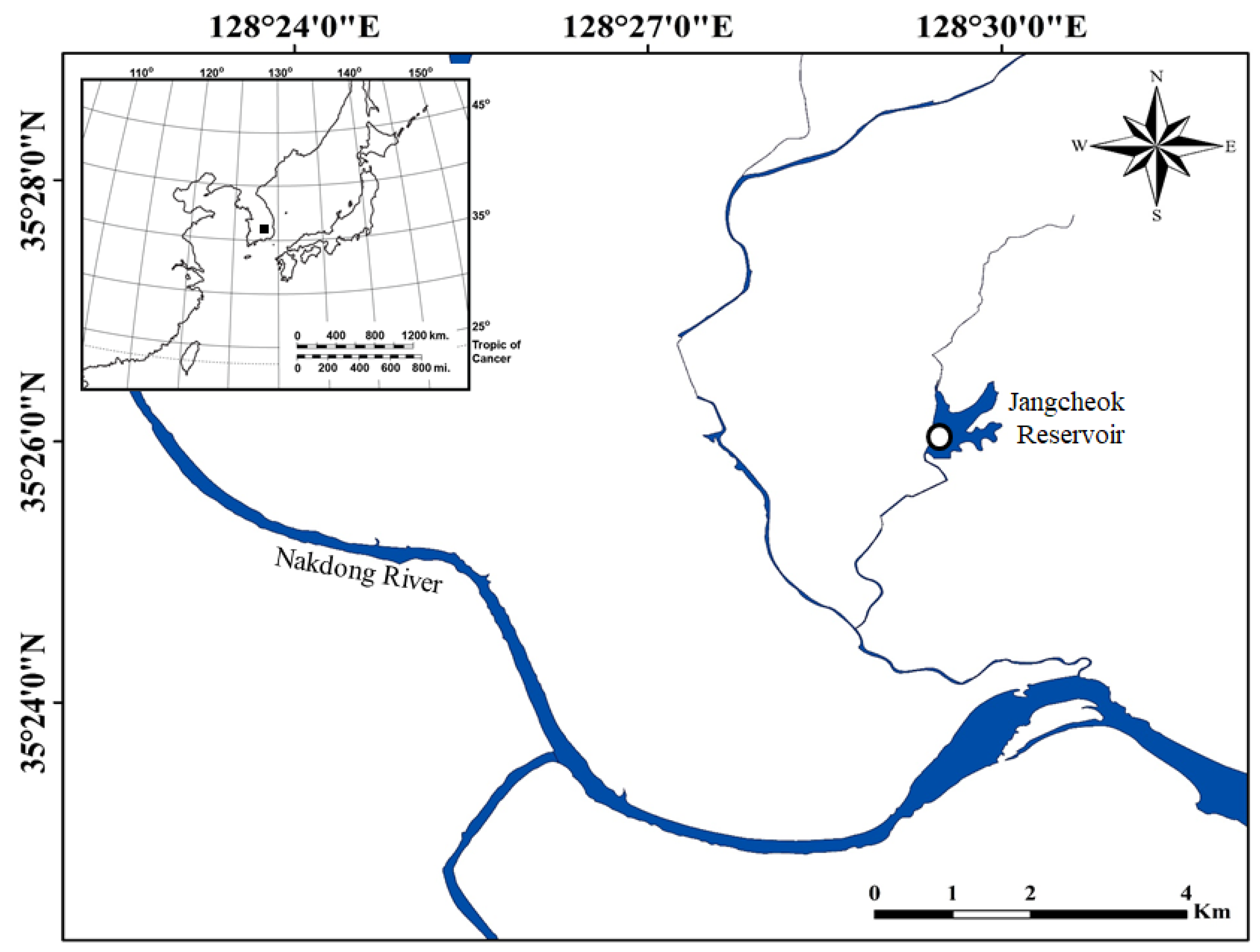
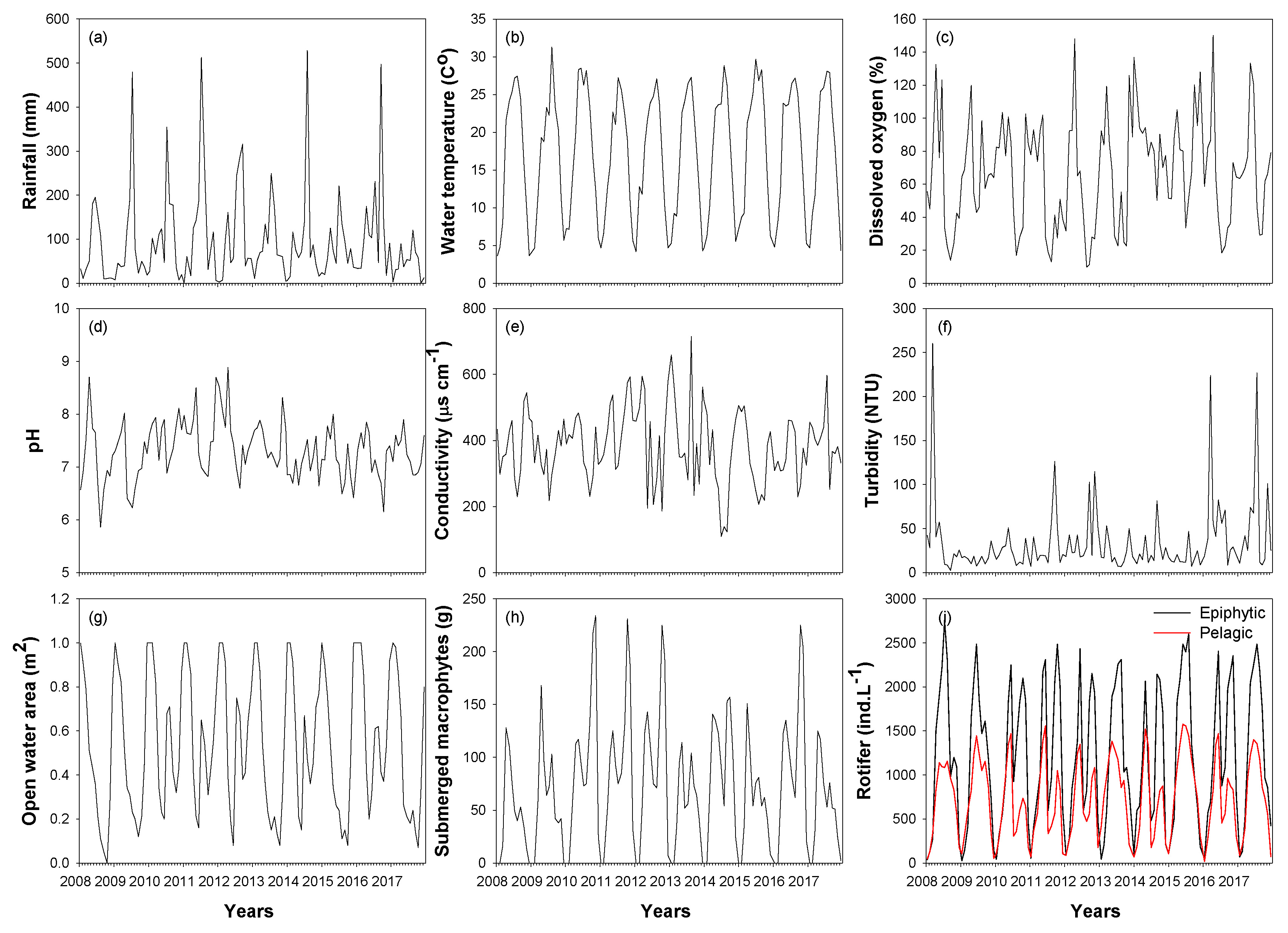

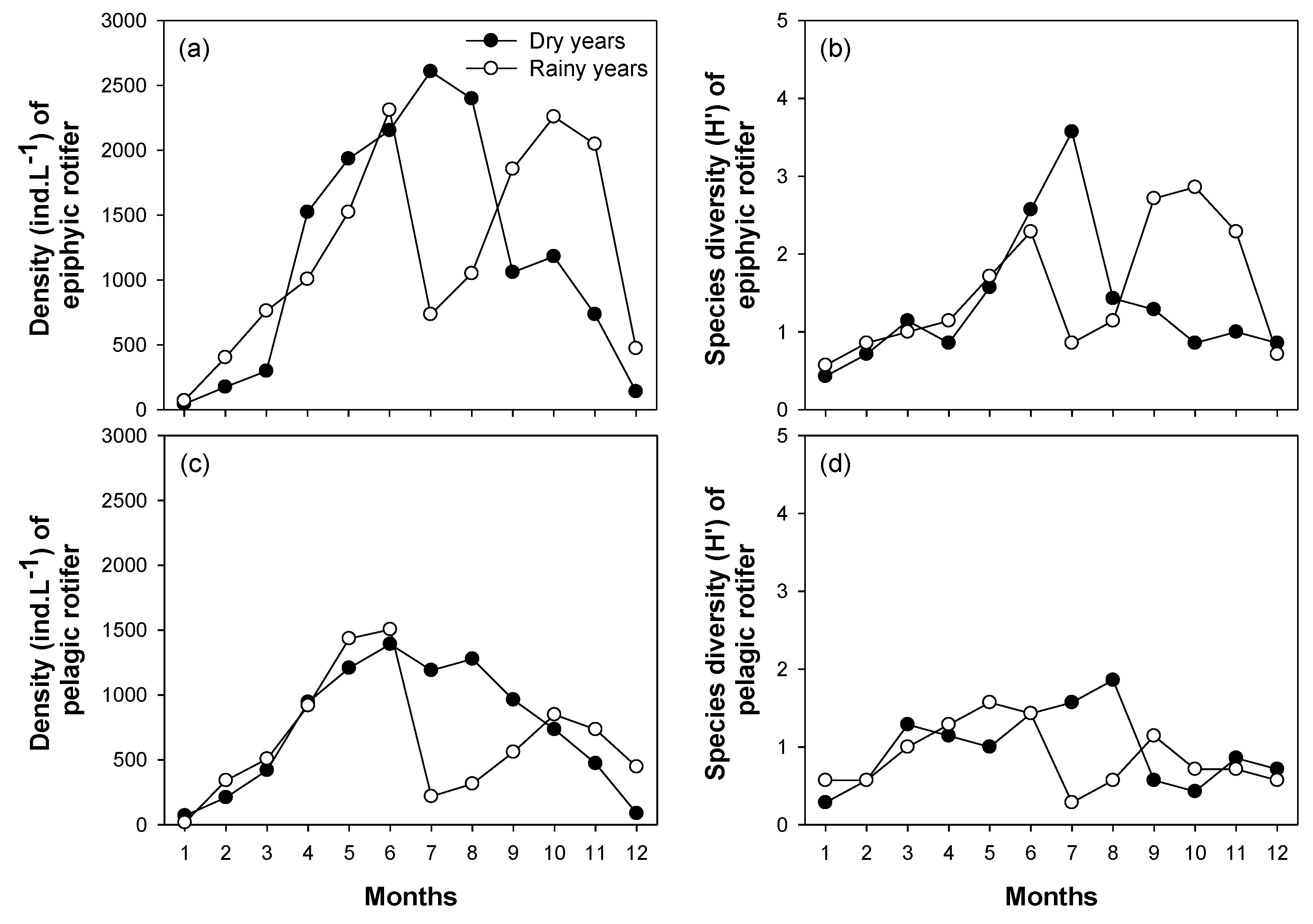
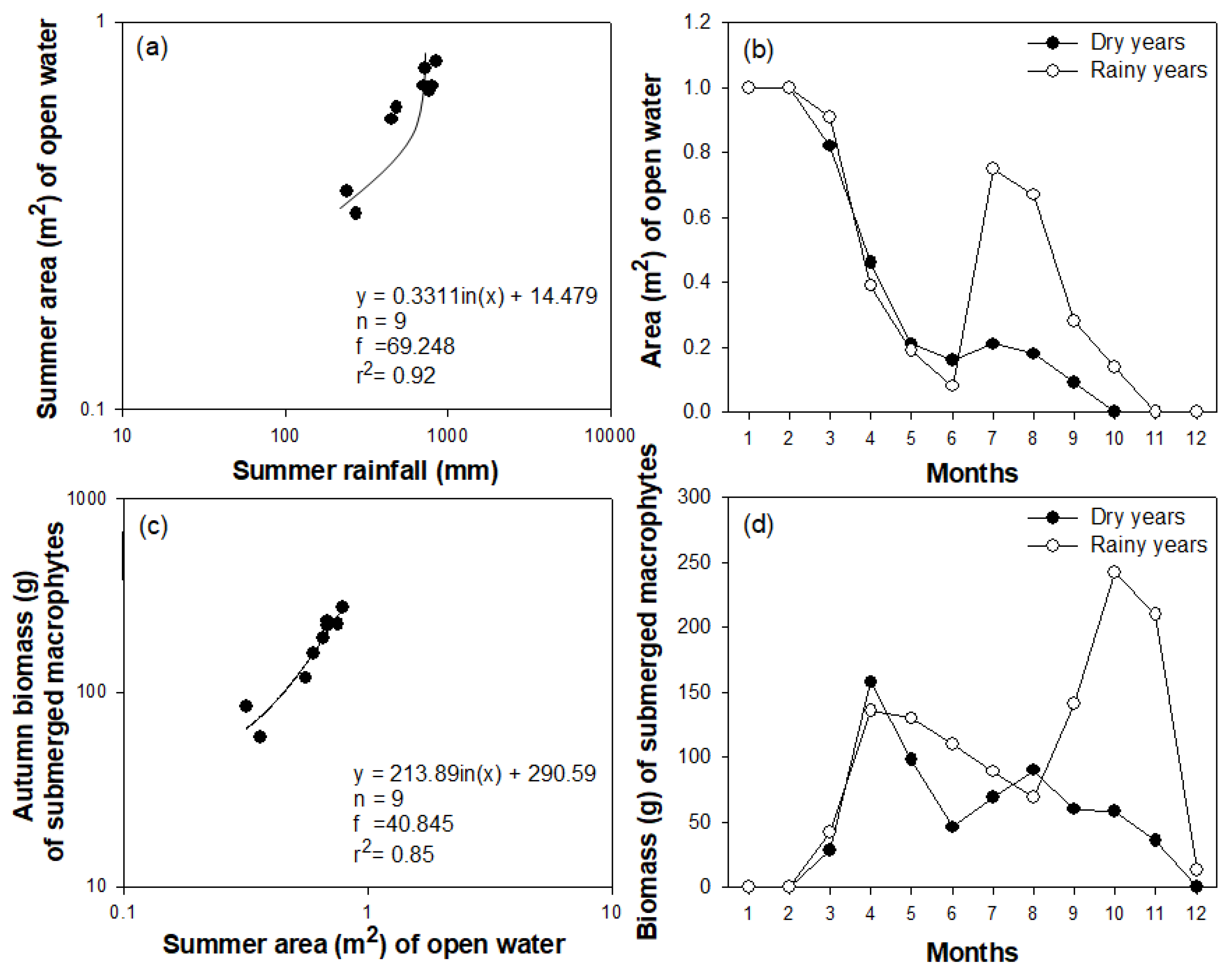
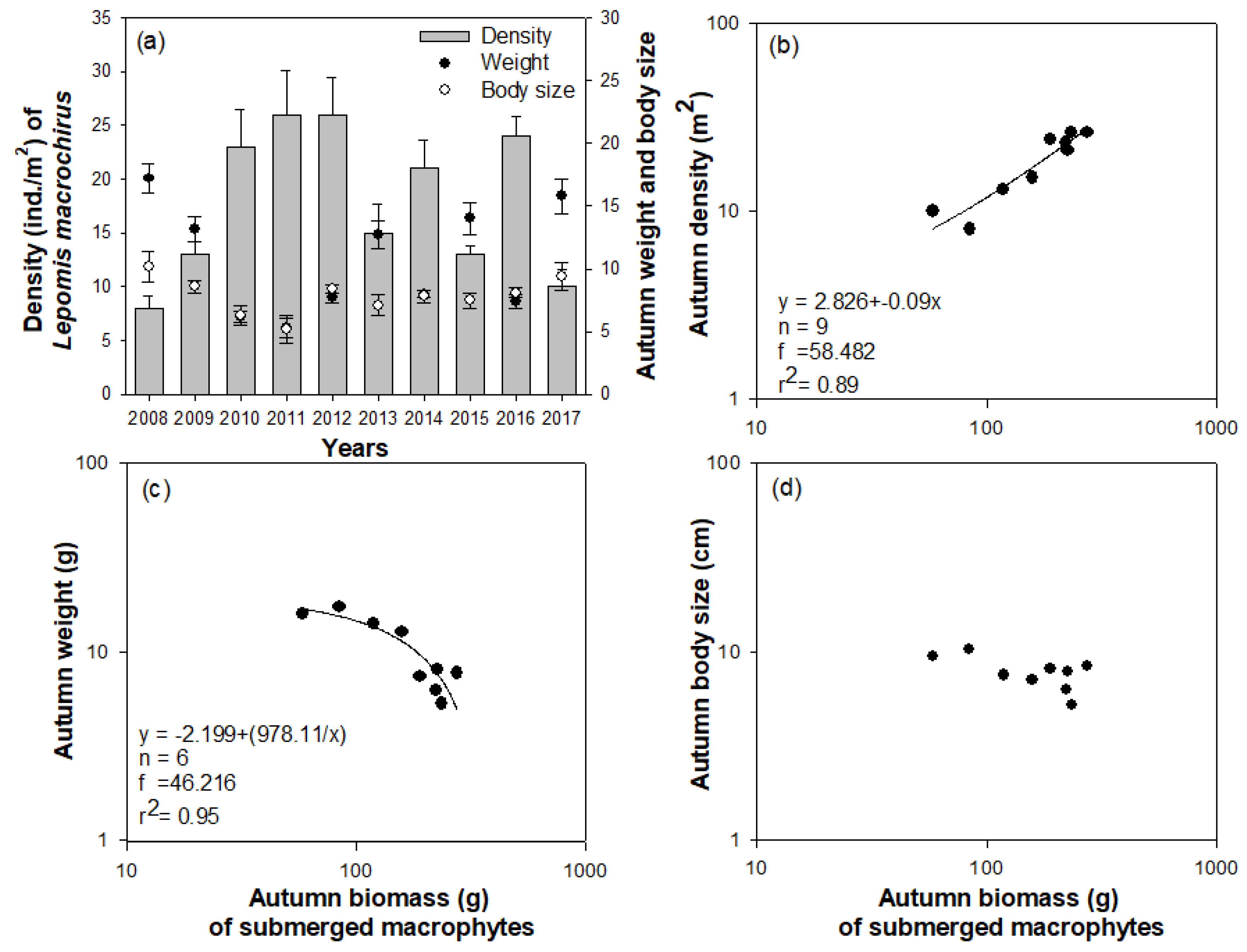
| Rotifer types | Variables | Seasons | df | F | p |
|---|---|---|---|---|---|
| Epiphytic | Density | Spring | 1 | 1.543 | 0.098 |
| Summer | 1 | 7.735 | <0.01 | ||
| Autumn | 1 | 8.626 | <0.01 | ||
| Winter | 1 | 1.035 | 0.433 | ||
| Diversity | Spring | 1 | 0.865 | 0.589 | |
| Summer | 1 | 6.642 | <0.05 | ||
| Autumn | 1 | 8.392 | <0.01 | ||
| Winter | 1 | 1.322 | 0.234 | ||
| Pelagic | Density | Spring | 1 | 1.243 | 0.267 |
| Summer | 1 | 8.461 | <0.01 | ||
| Autumn | 1 | 1.611 | 0.064 | ||
| Winter | 1 | 0.942 | 0.518 | ||
| Diversity | Spring | 1 | 1.043 | 0.412 | |
| Summer | 1 | 6.822 | <0.05 | ||
| Autumn | 1 | 1.254 | 0.251 | ||
| Winter | 1 | 1.127 | 0.343 |
© 2020 by the authors. Licensee MDPI, Basel, Switzerland. This article is an open access article distributed under the terms and conditions of the Creative Commons Attribution (CC BY) license (http://creativecommons.org/licenses/by/4.0/).
Share and Cite
Choi, J.-Y.; Kim, S.-K. Responses of Rotifer Community to Microhabitat Changes Caused by Summer-Concentrated Rainfall in a Shallow Reservoir, South Korea. Diversity 2020, 12, 113. https://doi.org/10.3390/d12030113
Choi J-Y, Kim S-K. Responses of Rotifer Community to Microhabitat Changes Caused by Summer-Concentrated Rainfall in a Shallow Reservoir, South Korea. Diversity. 2020; 12(3):113. https://doi.org/10.3390/d12030113
Chicago/Turabian StyleChoi, Jong-Yun, and Seong-Ki Kim. 2020. "Responses of Rotifer Community to Microhabitat Changes Caused by Summer-Concentrated Rainfall in a Shallow Reservoir, South Korea" Diversity 12, no. 3: 113. https://doi.org/10.3390/d12030113
APA StyleChoi, J.-Y., & Kim, S.-K. (2020). Responses of Rotifer Community to Microhabitat Changes Caused by Summer-Concentrated Rainfall in a Shallow Reservoir, South Korea. Diversity, 12(3), 113. https://doi.org/10.3390/d12030113





